The size of the tire curing bladder release agent market is forecast to rise from USD 185.3 billion in 2025 to USD 374.9 billion in 2035, advancing at a 7.3% CAGR. The tire curing bladder release agent industry stands at the threshold of a decade-long expansion trajectory that promises to reshape tire manufacturing technology and automotive industry chemical solutions.
The market's journey from USD 185.3 billion in 2025 to USD 374.9 billion by 2035 represents substantial growth, demonstrating the accelerating adoption of advanced release agent formulations and tire production optimization technology across passenger vehicle, commercial transport, and specialty tire manufacturing sectors.
The first half of the decade (2025-2030) will witness the market climbing from USD 185.3 billion to approximately USD 263.6 billion, adding USD 78.3 billion in value, which constitutes 41% of the total forecast growth period. This phase will be characterized by the rapid adoption of cobalt-based release agent systems, driven by increasing tire production volumes and the growing requirements of automotive manufacturing worldwide. Advanced chemical formulation capabilities and automated application systems will become standard expectations rather than premium options.
The latter half (2030-2035) will witness sustained growth from USD 263.6 billion to USD 374.9 billion, representing an addition of USD 111.3 billion or 59% of the decade's expansion. This period will be defined by mass market penetration of specialized release agent chemistries, integration with comprehensive tire manufacturing platforms, and seamless compatibility with existing production infrastructure. The market trajectory signals fundamental shifts in how tire manufacturers approach curing process optimization and production efficiency management, with participants positioned to benefit from sustained demand across multiple chemical types and application segments.
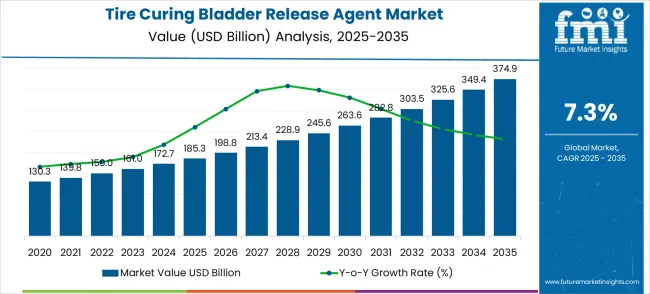
The Tire Curing Bladder Release Agent market demonstrates distinct growth phases with varying market characteristics and competitive dynamics. Between 2025 and 2030, the market progresses through its technology adoption phase, expanding from USD 185.3 billion to USD 263.6 billion with steady annual increments averaging 7.3% growth. This period showcases the transition from basic release agent formulations to advanced cobalt-based systems with enhanced performance capabilities and integrated quality control systems becoming mainstream features.
The 2025-2030 phase adds USD 78.3 billion to market value, representing 41% of total decade expansion. Market maturation factors include the standardization of tire manufacturing protocols, declining component costs for specialized chemical formulations, and increasing automotive industry awareness of release agent benefits, which reach 95-98% effectiveness in bladder separation applications. The competitive landscape during this period features established chemical companies, such as Umicore and DIC, expanding their tire curing portfolios, while specialty manufacturers focus on advanced formulation development and enhanced performance capabilities.
From 2030 to 2035, market dynamics shift toward advanced chemical integration and global tire production expansion, with growth accelerating from USD 263.6 billion to USD 374.9 billion, representing an addition of USD 111.3 billion, or 59% of the total expansion. This phase transition centers on specialized cobalt chemistry systems, integration with automated tire manufacturing networks, and deployment across diverse automotive production scenarios, becoming standard rather than specialized applications. The competitive environment matures with focus shifting from basic release agent capability to comprehensive tire manufacturing optimization systems and integration with production monitoring platforms.
| Metric | Value |
|---|---|
| Market Value (2025) → | USD 185.3 billion |
| Market Forecast (2035) ↑ | USD 374.9 billion |
| Growth Rate ★ | 7.3% CAGR |
| Leading Technology → | Cobalt Naphthenate Chemical Type |
| Primary Application → | Passenger Car Tires Segment |
The market demonstrates strong fundamentals with cobalt naphthenate systems capturing a dominant share through advanced chemical performance and tire production optimization capabilities. Passenger car tire applications drive primary demand, supported by increasing automotive production and tire manufacturing technology requirements. Geographic expansion remains concentrated in developed markets with established automotive infrastructure, while emerging economies exhibit accelerating adoption rates, driven by the expansion of automotive manufacturing and rising vehicle production standards.
Market expansion rests on three fundamental shifts driving adoption across the automotive and tire manufacturing sectors. 1. Automotive production demand creates compelling operational advantages through tire curing bladder release agents that provide immediate separation efficiency without production delays, enabling tire manufacturers to meet quality standards while maintaining manufacturing productivity and reducing operational costs. 2. Tire manufacturing modernization accelerates as production facilities worldwide seek advanced chemical systems that complement traditional curing processes, enabling precise bladder release and quality control applications that align with automotive industry standards and production efficiency regulations. 3. Manufacturing infrastructure enhancement drives adoption from tire production facilities and automotive manufacturers requiring effective release agent solutions that minimize production defects while maintaining operational productivity during tire curing and bladder separation operations.
However, growth faces headwinds from raw material cost challenges that vary across chemical suppliers regarding the sourcing of cobalt compounds and specialty chemicals, which may limit adoption in cost-sensitive manufacturing environments. Technical limitations also persist regarding chemical compatibility and environmental conditions that may reduce effectiveness in extreme temperature or humidity manufacturing environments, which affect release agent performance and production consistency.
Primary Classification: The market segments by chemical type into Cobalt Naphthenate, Cobalt Stearate, Cobalt Borate, Cobalt Caprylate, and Other categories, representing the evolution from basic release formulations to specialized chemical solutions for comprehensive tire manufacturing optimization.
Secondary Classification: Application segmentation divides the market into Passenger Car Tires, Commercial Vehicle Tires, and Other sectors, reflecting distinct requirements for release agent performance, production volume capacity, and manufacturing quality standards.
Regional Classification: Geographic distribution covers North America, Europe, Asia Pacific, Latin America, and the Middle East & Africa, with developed markets leading adoption while emerging economies show accelerating growth patterns driven by automotive manufacturing expansion programs.
The segmentation structure reveals technology progression from standard cobalt-based formulations toward specialized chemical systems with enhanced performance and automation capabilities, while application diversity spans from passenger vehicle tire production to specialized commercial and industrial tire manufacturing requiring precise release agent solutions.
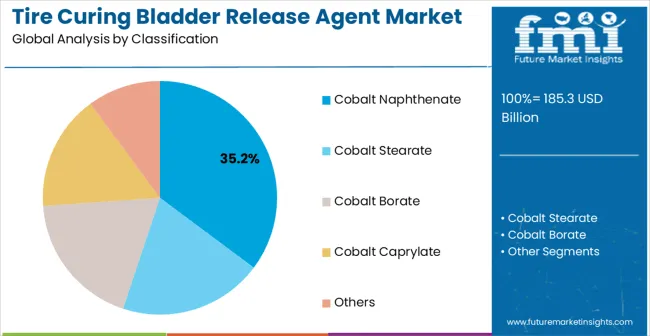
Market Position: Cobalt Naphthenate systems command the leading position in the Tire Curing Bladder Release Agent market with approximately 35.2% market share through advanced chemical performance features, including superior separation efficiency, thermal stability capability, and production optimization that enable tire manufacturers to achieve optimal bladder release across diverse automotive tire manufacturing environments.
Value Drivers: The segment benefits from tire manufacturer preference for reliable chemical systems that provide consistent bladder separation, reduced production defects, and manufacturing efficiency optimization without requiring significant process modifications. Advanced formulation features enable automated application systems, quality consistency, and integration with existing tire curing equipment, where chemical performance and production reliability represent critical operational requirements.
Competitive Advantages: Cobalt Naphthenate systems differentiate through proven chemical stability, consistent performance characteristics, and integration with automated tire manufacturing systems that enhance operational effectiveness while maintaining optimal tire quality suitable for diverse automotive and commercial applications.
Key market characteristics:
Cobalt Stearate systems maintain a significant 24.8% market share in the Tire Curing Bladder Release Agent market due to their specialized chemical properties and cost-effective formulation advantages. These systems appeal to tire manufacturers requiring balanced performance characteristics with competitive pricing for high-volume production applications. Market growth is driven by automotive manufacturing expansion, emphasizing reliable release agent solutions and operational efficiency through optimized chemical formulation systems.
Cobalt Borate systems hold approximately 18.1% market share, focusing on specialized tire manufacturing applications and enhanced chemical stability. These formulations demand advanced chemical engineering capabilities for extreme temperature resistance and specialized tire production scenarios requiring superior performance characteristics.
Cobalt Caprylate systems account for approximately 12.3% market share through specialized chemical properties and niche tire manufacturing applications. The segment focuses on premium tire production and specialized automotive applications requiring advanced chemical performance and manufacturing precision.
Other chemical systems represent approximately 9.6% market share, including specialty cobalt compounds, alternative metal-based formulations, and emerging chemical technologies for specialized tire manufacturing applications.
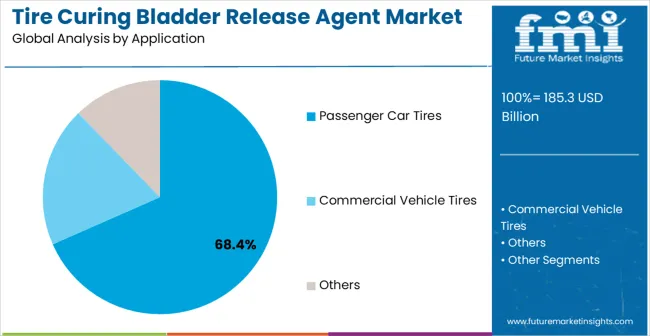
Market Context: Passenger car tire applications dominate the Tire Curing Bladder Release Agent market with approximately 68.4% market share due to widespread adoption of release agent systems and increasing focus on tire quality optimization, production efficiency management, and manufacturing cost reduction applications that minimize production defects while maintaining automotive industry standards.
Appeal Factors: Passenger car tire manufacturers prioritize system reliability, production consistency, and integration with existing tire manufacturing infrastructure that enables coordinated release agent application across multiple production lines. The segment benefits from substantial automotive industry investment and modernization programs that emphasize release agent system acquisition for quality control and manufacturing efficiency applications.
Growth Drivers: Automotive production expansion programs incorporate tire curing bladder release agents as standard equipment for tire manufacturing operations, while passenger vehicle industry growth increases demand for advanced chemical capabilities that comply with automotive quality standards and minimize production defects.
Market Challenges: Varying automotive industry standards and tire manufacturing technology differences may limit system standardization across different production facilities or operational scenarios.
Application dynamics include:
Commercial vehicle tire applications capture approximately 24.7% market share through specialized release agent requirements in heavy-duty tire manufacturing, truck tire production, and commercial transportation applications. These facilities demand robust chemical systems capable of operating in high-volume production environments while providing effective bladder separation and manufacturing quality capabilities.
Other tire applications account for approximately 6.9% market share, including specialty tire manufacturing, industrial tire production, and specialized automotive applications requiring release agent capabilities for manufacturing optimization and quality control.
Growth Accelerators: Automotive production expansion drives primary adoption as tire curing bladder release agents provide separation efficiency capabilities that enable tire manufacturers to meet automotive quality standards without excessive production delays, supporting manufacturing operations and automotive industry missions that require precise bladder release applications. Tire manufacturing infrastructure demand accelerates market expansion as production facilities seek effective chemical systems that minimize manufacturing defects while maintaining operational effectiveness during tire curing and bladder separation scenarios. Chemical technology spending increases worldwide, creating sustained demand for release agent systems that complement traditional tire manufacturing and provide operational flexibility in complex automotive production environments.
Growth Inhibitors: Raw material cost challenges vary across chemical suppliers regarding the sourcing of cobalt compounds and specialty chemical ingredients, which may limit operational flexibility and market penetration in regions with volatile commodity prices or cost-sensitive tire manufacturing operations. Technical performance limitations persist regarding chemical compatibility and environmental conditions that may reduce effectiveness in extreme temperature, humidity, or production environment conditions, affecting release agent performance and manufacturing consistency. Market fragmentation across multiple automotive specifications and tire manufacturing standards creates compatibility concerns between different chemical suppliers and existing production infrastructure.
Market Evolution Patterns: Adoption accelerates in automotive manufacturing and tire production sectors where quality requirements justify chemical system costs, with geographic concentration in developed markets transitioning toward mainstream adoption in emerging economies driven by automotive manufacturing expansion and tire production development. Technology development focuses on enhanced chemical formulations, improved thermal stability, and integration with automated manufacturing systems that optimize bladder separation and operational effectiveness. The market could face disruption if alternative tire manufacturing technologies or environmental regulations significantly limit cobalt-based release agent deployment in automotive or tire production applications.
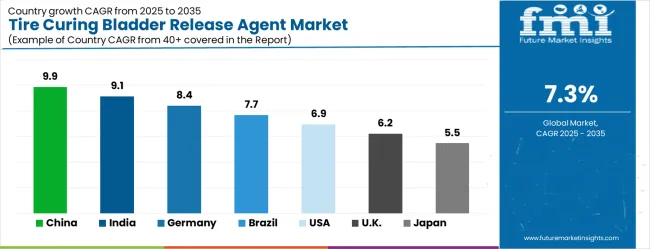
| Country | Market Share (2025) |
|---|---|
| China | 9.9% |
| India | 9.1% |
| Germany | 8.4% |
| Brazil | 7.7% |
| USA | 6.9% |
| UK | 6.2% |
| Japan | 5.5% |
The tire curing bladder release agent market demonstrates varied regional dynamics, with Growth Leaders including China (9.9% market share) and India (9.1% market share) driving expansion through automotive manufacturing expansion and tire production infrastructure development. Steady Performers encompass Germany (8.4% market share), Brazil (7.7% market share), and the USA (6.9% market share), benefiting from established automotive technology industries and advanced tire manufacturing adoption. Mature Markets feature the UK (6.2% market share) and Japan (5.5% market share), where specialized automotive applications and tire manufacturing technology integration support consistent growth patterns.
Regional synthesis reveals Asia-Pacific markets leading adoption through automotive manufacturing expansion and tire production infrastructure development, while European countries maintain steady expansion supported by automotive technology advancement and manufacturing standardization requirements. North American markets show moderate growth driven by automotive industry applications and chemical technology integration trends.
The report covers an in-depth analysis of 40+ countries top-performing countries are highlighted below.
China establishes market leadership through aggressive automotive manufacturing programs and comprehensive tire production infrastructure development, integrating advanced tire curing bladder release agents as standard components in automotive tire production and commercial vehicle manufacturing installations. The country's 9.9% market share reflects government initiatives promoting automotive technology and domestic chemical manufacturing capabilities that mandate the use of advanced release agent systems in tire manufacturing and automotive production facilities. Growth concentrates in major industrial centers, including Shanghai, Guangzhou, and Tianjin, where automotive technology development showcases integrated chemical systems that appeal to domestic tire manufacturers seeking advanced production optimization capabilities and manufacturing efficiency applications.
Chinese chemical manufacturers are developing cost-effective release agent solutions that combine domestic production advantages with advanced performance features, including automated application systems and enhanced chemical stability capabilities. Distribution channels through automotive industry suppliers and chemical equipment distributors expand market access, while government support for automotive manufacturing development supports adoption across diverse tire production and automotive manufacturing segments.
Strategic Market Indicators:
In Mumbai, Chennai, and Delhi, automotive manufacturing facilities and tire production plants are implementing advanced tire curing bladder release agents as standard equipment for production optimization and quality control applications, driven by increasing automotive industry investment and manufacturing modernization programs that emphasize the importance of chemical system capabilities. The market holds a 9.1% share, supported by government automotive manufacturing initiatives and industrial infrastructure development programs that promote advanced chemical systems for tire manufacturing and automotive production facilities. Indian tire manufacturers are adopting release agent systems that provide consistent production performance and quality control features, particularly appealing in automotive regions where manufacturing efficiency and product quality represent critical operational requirements.
Market expansion benefits from growing automotive chemical manufacturing capabilities and international technology transfer agreements that enable domestic production of advanced release agent systems for tire manufacturing and automotive applications. Technology adoption follows patterns established in automotive chemicals, where reliability and performance drive procurement decisions and operational deployment.
Market Intelligence Brief:
Advanced automotive chemical market in Germany demonstrates sophisticated tire curing bladder release agent deployment with documented operational effectiveness in tire manufacturing applications and automotive production facilities through integration with existing chemical systems and production infrastructure. The country leverages engineering expertise in automotive chemicals and manufacturing systems integration to maintain an 8.4% market share. Industrial centers, including Stuttgart, Munich, and Frankfurt, showcase premium installations where release agent systems integrate with comprehensive automotive platforms and manufacturing management systems to optimize tire production and quality effectiveness.
German chemical companies prioritize system reliability and EU compliance in the development of release agents, creating demand for premium chemical systems with advanced features, including production monitoring integration and automated application systems. The market benefits from established automotive chemical infrastructure and a willingness to invest in advanced tire manufacturing technologies that provide long-term operational benefits and compliance with international automotive standards.
Market Intelligence Brief:
Market in Brazil expansion benefits from diverse automotive demand, including tire manufacturing modernization in São Paulo and Rio de Janeiro, commercial vehicle production upgrades, and government automotive programs that increasingly incorporate release agent solutions for manufacturing optimization applications. The country maintains a 7.7% market share, driven by rising automotive production and increasing awareness of chemical technology benefits, including precise production control and reduced manufacturing defect capabilities.
Market dynamics focus on cost-effective release agent solutions that balance advanced chemical performance with affordability considerations important to Brazilian tire manufacturers. Growing automotive industrialization creates sustained demand for modern chemical systems in new manufacturing infrastructure and facility modernization projects.
Strategic Market Considerations:
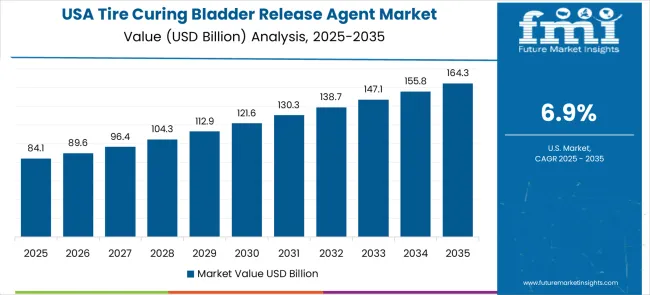
The USA market emphasizes advanced release agent features, including precision chemical control and integration with comprehensive manufacturing platforms that manage production quality, efficiency optimization, and cost control applications through unified monitoring systems. The country holds a 6.9% market share, driven by automotive manufacturing modernization and tire production equipment upgrades that support chemical system integration. American tire manufacturers prioritize operational effectiveness with release agent systems delivering consistent production performance through advanced chemical formulation algorithms and manufacturing adaptation capabilities.
Technology deployment channels include major automotive chemical contractors, specialized manufacturing equipment suppliers, and automotive industry procurement programs that support professional applications for complex tire manufacturing applications. Manufacturing platform integration capabilities with established automotive systems expand market appeal across diverse operational requirements seeking precision and reliability benefits.
Performance Metrics:
Japan demonstrates steady market development with a 5.5% market share, distinguished by tire manufacturing facilities' preference for high-quality release agent systems that integrate seamlessly with existing automotive systems and provide reliable long-term operation in specialized tire production applications. The market prioritizes advanced features, including precision chemical control, environmental durability, and integration with comprehensive manufacturing platforms that reflect Japanese automotive industry expectations for technological sophistication and operational excellence.
In Birmingham, Manchester, and other automotive centers, British tire manufacturing facilities and automotive production plants are implementing advanced release agent systems to enhance production optimization capabilities and support tire manufacturing operations that align with automotive industry regulations and quality standards. The UK market holds a 6.2% market share, driven by automotive modernization programs and manufacturing equipment upgrades that emphasize advanced chemical systems for tire production and automotive applications. British tire manufacturers are prioritizing release agent systems that provide consistent production performance while maintaining compliance with automotive regulations and minimizing manufacturing defects, particularly important in automotive operations and tire manufacturing facilities.
Market expansion benefits from government automotive procurement programs that mandate chemical performance capabilities in manufacturing equipment specifications, creating sustained demand across the UK's tire manufacturing and automotive sectors, where operational flexibility and precision represent critical requirements. The regulatory framework supports release agent adoption through automotive equipment standards and compliance requirements that promote advanced chemical systems aligned with production quality management capabilities.
Strategic Market Indicators:
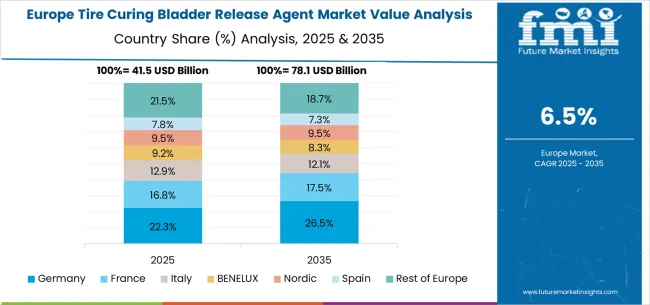
The European Tire Curing Bladder Release Agent market is projected to grow from USD 41.2 billion in 2025 to USD 83.4 billion by 2035, registering a CAGR of 7.3% over the forecast period. Germany is expected to maintain its leadership position with a 32.1% market share in 2025, declining slightly to 31.8% by 2035, supported by its advanced automotive chemical infrastructure and major tire manufacturing centers, including Stuttgart and Munich.
France follows with a 25.4% share in 2025, projected to reach 25.8% by 2035, driven by comprehensive automotive manufacturing programs and chemical technology development initiatives. The United Kingdom holds an 18.9% share in 2025, expected to maintain 18.6% by 2035 through specialized automotive applications and EU compliance requirements. Italy commands a 13.2% share, while Spain accounts for 9.4% in 2025. The Rest of Europe region is anticipated to gain momentum, expanding its collective share from 6.7% to 7.1% by 2035, attributed to increasing automotive manufacturing adoption in Nordic countries and emerging Eastern European tire production facilities implementing manufacturing modernization programs.
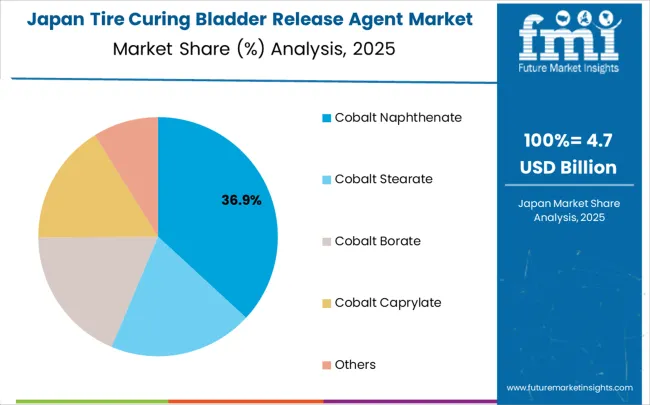
In Japan, the Tire Curing Bladder Release Agent market prioritizes cobalt naphthenate systems, which capture the dominant share of tire manufacturing and automotive production installations due to their advanced features, including precision chemical performance optimization and seamless integration with existing tire manufacturing infrastructure. Japanese tire manufacturers emphasize reliability, precision, and long-term operational excellence, creating demand for cobalt naphthenate systems that provide consistent production capabilities and adaptive chemical performance based on manufacturing requirements and environmental conditions. Other chemical types maintain secondary positions primarily in specialized applications and commercial tire installations where comprehensive performance functionality meets operational requirements without compromising production efficiency.
Market Characteristics:
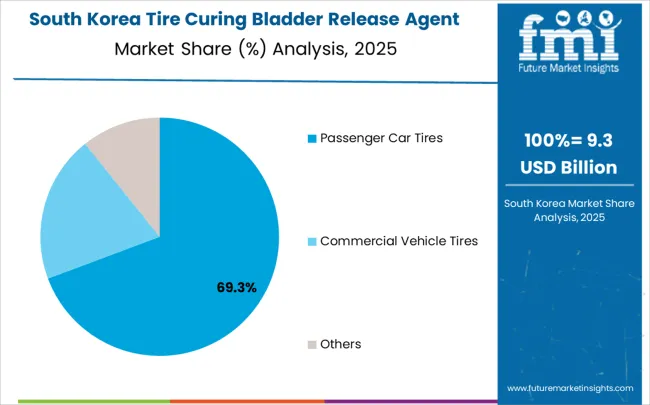
In South Korea, the market structure favors international chemical companies, including Umicore, DIC, and Milliken, which maintain dominant positions through comprehensive product portfolios and established automotive industry networks supporting both tire manufacturing and automotive production installations. These providers offer integrated solutions combining advanced release agent systems with professional application services and ongoing technical support that appeal to Korean tire manufacturers seeking reliable automotive chemical systems. Local chemical contractors and system integrators capture a moderate market share by providing localized service capabilities and competitive pricing for standard tire manufacturing installations. At the same time, domestic manufacturers focus on specialized applications and cost-effective solutions tailored to Korean automotive characteristics.
Channel Insights:
The Tire Curing Bladder Release Agent market operates with moderate concentration, featuring approximately 18-22 meaningful participants, where leading companies control roughly 45-50% of the global market share through established automotive industry relationships and comprehensive chemical portfolios. Competition emphasizes advanced chemical formulation capabilities, system reliability, and manufacturing platform integration rather than price-based rivalry.
Market Leaders encompass Umicore, DIC, and Milliken, which maintain competitive advantages through extensive automotive chemical expertise, global tire manufacturing contractor networks, and comprehensive system integration capabilities that create customer switching costs and support premium pricing. These companies leverage decades of chemical technology experience and ongoing research investments to develop advanced release agent systems with precision performance control and manufacturing monitoring features.
Technology Innovators include Manchem, Coremaxcorp, and Shanghai Sansi Additives Products, which compete through specialized chemical formulation technology focus and innovative application interfaces that appeal to tire manufacturers seeking advanced performance capabilities and operational flexibility. These companies differentiate through rapid chemical development cycles and specialized automotive application focus.
Regional Specialists feature companies like Zhenjiang Matt Chemical New Materials, Yixing Kaou Chemicals, and Jiangyin Sanliang Chemicals, which focus on specific geographic markets and specialized applications, including cobalt-based systems and integrated manufacturing solutions. Market dynamics favor participants that combine reliable chemical formulations with advanced application software, including precision chemical control and automatic performance optimization capabilities. Competitive pressure intensifies as traditional automotive chemical contractors expand into release agent systems. In contrast, specialized chemical companies challenge established players through innovative formulation solutions and cost-effective platforms targeting specialized tire manufacturing segments.
Tire curing bladder release agents represent specialized chemical solutions that enable tire manufacturers to achieve optimal bladder separation efficiency (95-98% effectiveness), reduce production defects, and maintain consistent manufacturing quality without compromising production throughput or tire integrity during the vulcanization process. With the market experiencing substantial growth driven by automotive production expansion and tire manufacturing modernization, these chemical systems offer compelling advantages - superior separation performance, thermal stability, and integration compatibility with automated production lines - making them essential for passenger car tire production (68.4% market share), commercial vehicle manufacturing (24.7% share), and specialized tire applications seeking alternatives to traditional mechanical separation methods. Scaling market adoption and chemical innovation requires coordinated action across automotive industry policy, chemical safety standards, specialty chemical manufacturers, tire production facilities, and industrial investment capital.
How Governments Could Spur Local Production and Adoption?
How Industry Bodies Could Support Market Development?
How OEMs and Chemical Technology Players Could Strengthen the Ecosystem?
How Suppliers Could Navigate the Shift?
How Investors and Financial Enablers Could Unlock Value?
| Item | Value |
|---|---|
| Quantitative Units | USD 185.3 billion |
| Chemical Type | Cobalt Naphthenate, Cobalt Stearate, Cobalt Borate, Cobalt Caprylate, Others |
| Application | Passenger Car Tires, Commercial Vehicle Tires, Others |
| Regions Covered | North America, Europe, Asia Pacific, Latin America, Middle East & Africa |
| Countries Covered | China, India, Germany, Brazil, the USA, the UK, Japan, and 25+ additional countries |
| Key Companies Profiled | Umicore, DIC, Milliken, Manchem, Coremaxcorp, Shanghai Sansi Additives Products, Zhenjiang Matt Chemical New Materials |
| Additional Attributes | Dollar sales by chemical type and application categories, regional adoption trends across North America, Europe, and Asia-Pacific, competitive landscape with chemical manufacturers and automotive suppliers, tire manufacturer preferences for precision separation control and system reliability, integration with tire manufacturing platforms and production monitoring systems, innovations in cobalt-based formulations and environmental durability, and development of automated application solutions with enhanced performance and manufacturing optimization capabilities. |
The global tire curing bladder release agent market is estimated to be valued at USD 185.3 billion in 2025.
The market size for the tire curing bladder release agent market is projected to reach USD 374.9 billion by 2035.
The tire curing bladder release agent market is expected to grow at a 7.3% CAGR between 2025 and 2035.
The key product types in tire curing bladder release agent market are cobalt naphthenate, cobalt stearate, cobalt borate, cobalt caprylate and others.
In terms of application, passenger car tires segment to command 68.4% share in the tire curing bladder release agent market in 2025.






Our Research Products

The "Full Research Suite" delivers actionable market intel, deep dives on markets or technologies, so clients act faster, cut risk, and unlock growth.

The Leaderboard benchmarks and ranks top vendors, classifying them as Established Leaders, Leading Challengers, or Disruptors & Challengers.

Locates where complements amplify value and substitutes erode it, forecasting net impact by horizon

We deliver granular, decision-grade intel: market sizing, 5-year forecasts, pricing, adoption, usage, revenue, and operational KPIs—plus competitor tracking, regulation, and value chains—across 60 countries broadly.

Spot the shifts before they hit your P&L. We track inflection points, adoption curves, pricing moves, and ecosystem plays to show where demand is heading, why it is changing, and what to do next across high-growth markets and disruptive tech

Real-time reads of user behavior. We track shifting priorities, perceptions of today’s and next-gen services, and provider experience, then pace how fast tech moves from trial to adoption, blending buyer, consumer, and channel inputs with social signals (#WhySwitch, #UX).

Partner with our analyst team to build a custom report designed around your business priorities. From analysing market trends to assessing competitors or crafting bespoke datasets, we tailor insights to your needs.
Supplier Intelligence
Discovery & Profiling
Capacity & Footprint
Performance & Risk
Compliance & Governance
Commercial Readiness
Who Supplies Whom
Scorecards & Shortlists
Playbooks & Docs
Category Intelligence
Definition & Scope
Demand & Use Cases
Cost Drivers
Market Structure
Supply Chain Map
Trade & Policy
Operating Norms
Deliverables
Buyer Intelligence
Account Basics
Spend & Scope
Procurement Model
Vendor Requirements
Terms & Policies
Entry Strategy
Pain Points & Triggers
Outputs
Pricing Analysis
Benchmarks
Trends
Should-Cost
Indexation
Landed Cost
Commercial Terms
Deliverables
Brand Analysis
Positioning & Value Prop
Share & Presence
Customer Evidence
Go-to-Market
Digital & Reputation
Compliance & Trust
KPIs & Gaps
Outputs
Full Research Suite comprises of:
Market outlook & trends analysis
Interviews & case studies
Strategic recommendations
Vendor profiles & capabilities analysis
5-year forecasts
8 regions and 60+ country-level data splits
Market segment data splits
12 months of continuous data updates
DELIVERED AS:
PDF EXCEL ONLINE
Tire Marking Machine Market Size and Share Forecast Outlook 2025 to 2035
Tire Pressure Monitoring System Market Size and Share Forecast Outlook 2025 to 2035
Tire Cord Fabric Market Size and Share Forecast Outlook 2025 to 2035
Tire Retreading Equipment Market Size and Share Forecast Outlook 2025 to 2035
Tire Cobalt Salt Adhesive Market Size and Share Forecast Outlook 2025 to 2035
Tire and Wheel Handling Equipment Market Size and Share Forecast Outlook 2025 to 2035
Tire Changing Machines Market Size and Share Forecast Outlook 2025 to 2035
Tire Pyrolysis Oil Market Size and Share Forecast Outlook 2025 to 2035
Tire Cord and Tire Fabrics Market Size and Share Forecast Outlook 2025 to 2035
Tire Materials Market Insights – Size, Trends & Forecast 2025–2035
Tire Testing Machine Market Size and Share Forecast Outlook 2025 to 2035
Tire & Wheel Cleaners Market Size and Share Forecast Outlook 2025 to 2035
Tire Repair Patch Market Analysis By Type, Application, and Region Through 2035
Tire Inspection System Market - Outlook 2025 to 2035
Tire Changers - Market Growth - 2025 to 2035,
Tire Cutting Machine Market Trends, Outlook & Forecast 2025 to 2035
Tire Storage Rack Market Growth - Trends & Forecast 2025 to 2035
Tire Cord Market
Tire Carousel Market
Tire Inflating Machine Market

Thank you!
You will receive an email from our Business Development Manager. Please be sure to check your SPAM/JUNK folder too.
Chat With
MaRIA